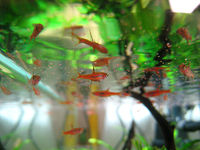Difference between revisions of "Boraras brigittae"
From The Aquarium Wiki
m |
|||
| Line 36: | Line 36: | ||
|max_water_hardness=10 | |max_water_hardness=10 | ||
}} | }} | ||
| − | + | ||
| − | + | == Sexing == | |
| − | + | :Females have broader body shape and the tail is rounded. Males are long and have a more slender body shape. | |
| − | + | ||
| − | + | ||
| − | + | == Tank compatibility == | |
| − | + | :Due to this tiny fish's size, they are best kept in groups of at least 6 of their own kind in a species tank or with other very small peaceful micro fish such as [[Ember Tetra]]s and [[Pygmy Cory]]s. | |
| − | + | ||
| − | + | ||
| + | == Diet == | ||
| + | :Flake food is a good diet for the Mosquito Rasbora. They will also take tiny pieces of [[bloodworm]] and [[daphnia]]. | ||
| + | |||
| + | |||
| + | == Feeding regime == | ||
| + | :Feed once or twice a day. | ||
| + | |||
| + | |||
| + | == Environment specifics == | ||
| + | :They need a spacious tank with hiding spaces and an open swimming space. Dense planting is a must for them to hide in if and when they are startled and at night. | ||
| + | |||
| + | |||
| + | == Behaviour == | ||
| + | :They are sometimes shy and will hide among plants. They will often shoal very tightly and stay together. | ||
| + | |||
| + | |||
| + | == Identification == | ||
| + | :A small and slender fish which is vivid red in colour, with a black band running down the lateral line, wider at the gill plates and slender towards the caudal fin. The fins also have red colour. | ||
| + | |||
| + | |||
{{Categories | {{Categories | ||
|Category=Fish, Fish (Freshwater), Cyprinids, Rasboras, Shoaling Community Fish | |Category=Fish, Fish (Freshwater), Cyprinids, Rasboras, Shoaling Community Fish | ||
Revision as of 03:18, 13 December 2017
Mosquito Rasbora
Boraras brigittae
38 Litres (10 US G.)
1.3-1.8cm (0.5-0.7 ")
Freshwater
6.5 - 7.0
25 -28 °C (77-82.4°F)
8-10 °d
1:2 M:F
4-8 years
Family
Cyprinidae
Contents
Additional names
- Mosquito Rasbora, Chilli Rasbora, Brigitte Rasbora, Micro Rasbora Brigitte, Dwarf Redfin Rasbora
Additional scientific names
- Rasbora urophthalma brigittae, Rasbora brigittae
Sexing
- Females have broader body shape and the tail is rounded. Males are long and have a more slender body shape.
Tank compatibility
- Due to this tiny fish's size, they are best kept in groups of at least 6 of their own kind in a species tank or with other very small peaceful micro fish such as Ember Tetras and Pygmy Corys.
Diet
- Flake food is a good diet for the Mosquito Rasbora. They will also take tiny pieces of bloodworm and daphnia.
Feeding regime
- Feed once or twice a day.
Environment specifics
- They need a spacious tank with hiding spaces and an open swimming space. Dense planting is a must for them to hide in if and when they are startled and at night.
Behaviour
- They are sometimes shy and will hide among plants. They will often shoal very tightly and stay together.
Identification
- A small and slender fish which is vivid red in colour, with a black band running down the lateral line, wider at the gill plates and slender towards the caudal fin. The fins also have red colour.
Pictures
Videos
External links
- Fishbase (Mirrors:
 )
)
